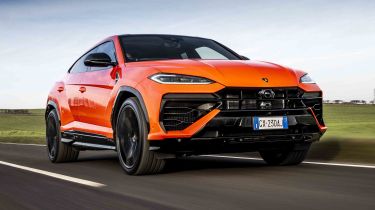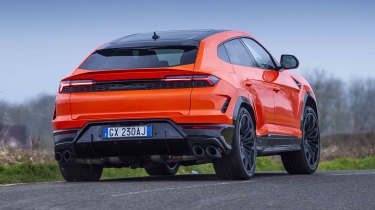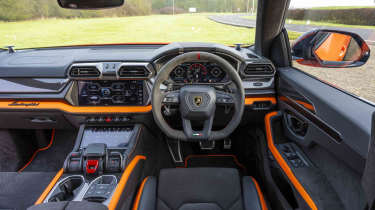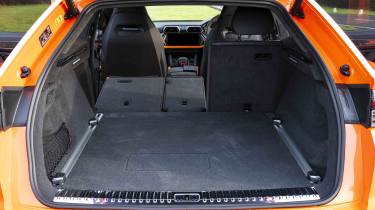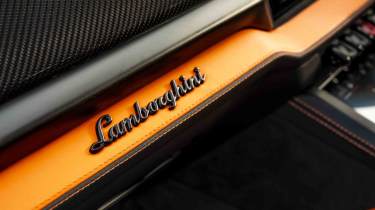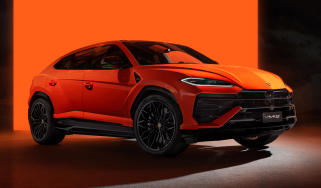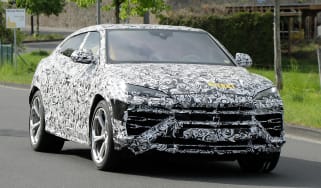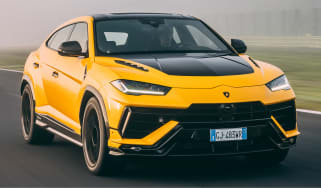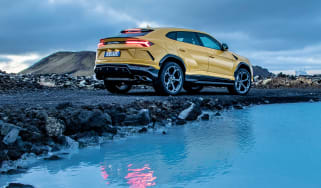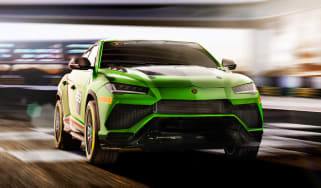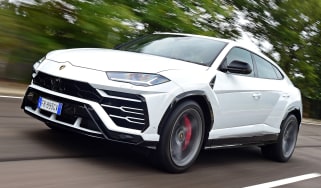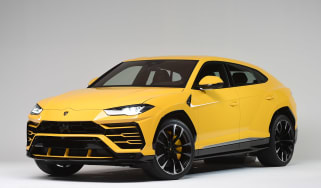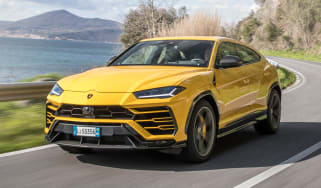Lamborghini Urus review
Traditional school run SUVs will be cowering in fear when you rock up to the playground in your twin-turbo V8 Lamborghini Urus

Is the Lamborghini Urus a good car?
Lamborghini’s entry into the hyper-SUV segment with its Urus has been an unqualified success because, in terms of sheer profitability, it’s done more for the brand’s bottom line than any other model in its history. The great news is that plenty of that revenue has gone into the next generation of its core supercars, but after six years on sale the SUV game has moved on – and so has the Urus, in the form of the SE model.
| Key specs | |
| Fuel type | Petrol, plug-in hybrid |
| Body style | Five-door SUV |
| Powertrain | 4.0-litre V8, twin-turbocharged, eight-speed dual-clutch auto, plus electric-motor, 25.9kWh battery pack, all-wheel drive |
| Safety | TBC |
| Warranty | 3ys/unlimited |
How much does a Lamborghini Urus cost?
The Lamborghini Urus SE costs from £208,000 in the UK. But there is no chance you’ll walk out of a showroom only paying that much, though, as options are both expensive and numerous.
Our test car was only moderately specified, yet the options still raised the total to nearly £300,000, largely on account of the insanely vivid Ad Personam paintwork, CorsaTex and carbon fibre interior packages, 23-inch wheels, contrasting roof and Bang & Olufsen sound system.
The basic equipment is all there, though, with Matrix LED headlights, 21-inch wheels, a dual-touchscreen infotainment system and even carbon ceramic brakes fitted as standard. In fact, those carbon brakes are the biggest fitted to any production car on sale right now.
Engines, performance and drive
The big change for the Urus SE is the addition of a plug-in hybrid system, pairing a twin-turbocharged 4.0-litre V8 engine with a hefty plug-in hybrid module made up of a 197bhp electric motor and 25.9kWh battery pack. Peak combined power is a staggering 789bhp, with torque rated at 950Nm. These are gains of 132bhp and 100Nm, but they haven’t come without cost.
Used - available now
This comes in the form of a 300kg-odd weight penalty, so performance is a little down compared with the previous Performante, but 0-62mph in 3.4 seconds is still more than enough to remain right at the top of the class, as is its 193mph top speed. The 25.9kWh battery pack can also drive the Urus SE on pure electric power for up to 37 miles at speeds of up to 83mph.
The e-motor sits between the engine and an eight-speed automatic transmission, sending power to all four wheels. There’s also an electronically-controlled limited slip differential at the rear, four-wheel steering, an active anti-roll system and the latest air suspension technology on dual-valve adaptive dampers.
These elements are controlled through a somewhat mystifying collection of seven drive modes, but the only ones you’ll need to worry about are the basic Strada, Sport, Corsa and Ego – the rest are options for use off-road.
Within each of these is a selection of four further powertrain modes, made up of EV, Hybrid, Recharge and Performance. EV mode does as it says, with Hybrid making a good fist of combining the e-motor and V8 to smoothly operate around town. Recharge will do the same, but puts a little more emphasis on the V8 to not only hold the current battery charge level, but slowly add to it as well.
Pull away in EV mode and there is some jerkiness as the e-motor’s power is sent through the gearbox, but it’s actually the tuneless piped-in sound that initially grates. Rather than sounding futuristic, or whatever else Lamborghini was aiming for during development, it instead has the irritating warble of a worn wheel-bearing. It’s not a great start.
Flick one of the drive mode levers and you can then engage Hybrid, where a generous prod of the throttle will awaken the V8 with all the fanfare you’d expect. There is no subtle slipping in and out of use, as you’ll find in a plug-in Bentley.
This is all well and good, but none of these modes screams Lamborghini in the same way as a naturally aspirated V12 engine, which is where the final Performance powertrain mode comes in. It’s here that the unit essentially acts as a pure combustion engine, with the 187bhp e-motor there purely as a form of added propulsion.
With Performance selected, the Urus SE is able to build some serious speed in the process, but the chassis and its hardware now feel more adept than was the case with the slightly wild previous-generation car.
There’s not a huge amount of feel, and the active anti-roll bars can make it a little tricky to get a sense of how much grip is available from the front tyres, but the quick steering and augmented powertrain shoot you down the road with confidence at an incredible pace.
Somewhat unsurprisingly, this car improves at speed – put some load into the suspension and the normally lumpy ride is smoothed out, while the e-motor better integrates itself into the overall powertrain. But it’s also ironic that at this point the Urus SE uses a colossal amount of fuel.
| Model | Power | 0-62mph | Top speed |
| Urus SE | 789bhp | 3.4 seconds | 193mph |
MPG, CO2 and running costs
Not that many in the market for an Urus will care about fuel consumption, but our mileage roughly matched the officially quoted 21.3mpg with a depleted battery. The official figure sits closer to 120mpg on the skewed WLTP combined rating, which will be largely impossible unless you charge at every stop and don’t do more than around 15-20 miles on a journey.
Lamborghini also quotes a 37-mile pure electric range, which is ambitious. This number is a best case scenario, and considering base Urus SE models run on relatively tiny 20-inch wheels, the move up to the 23-inch items our car (and most, let’s be honest) will run on will see that figure plummet. During our chilly test drive in mid-winter, we barely managed 10-15 miles.
Customers will probably approve of the tax benefits of the plug-in’s low 57g/km CO2 rating, though, especially if buying through a business. While the plug-in hybrid’s environmental credentials aren’t exactly going to save the planet, there are some advantages.
One potentially limiting factor for those tackling longer road trips is the smaller 75-litre petrol tank compared with the 85-litre tank of the previous S model.
The Urus SE is only rated to charge at 7.2kWs, with Lamborghini quoting a charging time of just under 4.5 hours to go from 20 to 100 per cent state of charge.
| Model | Battery size | Range | Insurance group |
| Urus SE | 25.9kWh | 37 miles | 50 |
Insurance
Group 50 insurance means the Lamborghini Urus falls into the most expensive category, as you would expect. Repair and replacement costs, coupled with extreme performance, are enough to give the average underwriter a cold sweat.
Depreciation
The flip side of potentially ruinous running costs is the fact that the waiting list for the Urus has kept resale values incredibly resilient. Despite it now being nearly seven years after launch, a used Urus costs around £140,000 in the UK – wild considering the original price was little more than £165,000 in 2018, and the fact these cars all have substantial mileage, given they’re often used as a daily driver.
To get an accurate valuation for a specific model, check out our free car valuation tool.
Design, interior and technology
Alongside the substantial changes under the skin is a more evolutionary set of upgrades to the design and interior. Neither is all new, but both have been tweaked with enough fresh elements to provide sufficient distinction from the previous generation.
Matrix headlights have been introduced, and sit on either side of a new bonnet that now extends right down to the front-end’s air intakes. This removes the unsightly part line of the previous model, making the whole car look much cleaner.
The rear end is also new, apparently inspired by the second-generation Gallardo with a full-width faux grille section and a change of number plate location. The effect is subtle, but also effectively cleans up the overall design.
Inside, Lamborghini has fitted a brand new dash to accommodate a larger 12.3-inch display. The lower touchscreen is as before, but the touch-sensitive controls that used to sit between them have been replaced with a new set of toggles which are lovely to use.
Most interior elements are also covered in expensive-feeling leather or, in the case of our test car, CorsaTex, which is Lamborghini’s version of Alcantara. This gives the whole cabin a definite uplift over most SUV rivals, but there are still too many elements from Audi, including the steering wheel controls, indicator stalks and window switches. These are all well built, but a little disappointing considering the price point.
Sat nav, stereo and infotainment
The new touchscreen has been borrowed from Porsche and Bentley, and is now larger at 12.3 inches. This sits above an Audi-sourced lower touchscreen for the heating, ventilation and seat controls, which works relatively well for these secondary functions. However, while the hardware is improved, with more digital real estate and better graphics, the interface is still tricky to navigate.
Most functions, like access to Apple CarPlay or switching off the active driver aids, are buried in menus that aren’t logical to access. There is a certain amount of personalisation to the overall system, but not enough to make the most difficult tasks less of a pain.
Our car was fitted with an upgraded Bang & Olufsen sound system which was excellent, if expensive at around £5,000, but there are two other set-ups available. The driver’s information display is also borrowed from Audi and features a range of bespoke graphics that are dependent on the driver mode. We found there to be a limited number of personalisation options, though, and once again the actual hardware is starting to feel its age.
Boot space, comfort & practicality
There’s only a five-door body style on offer, and the Lamborghini Urus comes with a traditional three-seater rear bench as standard. We’d advise going for a model with a panoramic roof to help bring some much-needed light into the rear cabin.
You sit lower in the Urus than in most SUVs, and while this fits the Lamborghini’s sporting feel it does mean visibility is not as good. It can be hard to place the car in town or tight parking spaces, although it’s less of an issue on the open road.
The seats are relatively comfortable, but no more, and while the added options of massage and cooling are a nice bonus, they lack the ultimate support you’d hope for from such a high-performance SUV.
| Dimensions | |
| Length | 5,112mm |
| Width | 2,016mm |
| Height | 1,638mm |
| Number of seats | 5 seats |
| Boot space | 454 litres |
Size
There’s no doubting the Lamborghini Urus has road presence. Even if it didn’t look quite so dramatic its 5,112mm length and 2,016mm width will turn heads. That said, it doesn’t take up quite as much space as the 5,1450mm x 2,224mm Bentley Bentayga. The Urus is also considerably lower than the Bentayga with a 1,638mm roof height compared to the 1,742mm Bentley.
Leg room, head room & passenger space
There’s plenty of room in the Lamborghini’s front seats, but the sloping, low-roofed body extracts a price in the back where both headroom and legroom for six-footers is in short supply. Additionally, the narrow window glass and relatively low seating position can make the rear seats feel a little claustrophobic – that’s quite at odds with the light and airy feel of many luxury SUV rivals.
Boot
The conversion to plug-in hybrid power has seen the boot shrink down to 454 litres from the 616 litres of its non-hybrid forbear. There’s no underfloor storage, and therefore nowhere clever to store the charging cable if you plan to take it with you. It is possible to fold the rear seats down if you need more space, though.
Safety and reliability
Lamborghini’s low volumes mean the Urus doesn’t undergo Euro NCAP safety tests, but the fact it shares most of its fundamental chassis and powertrain designs with five-star models like the Porsche Cayenne and Audi RS Q8 means it should still be a safe place to be if the worst happens.
Reliability is also more resilient than many might expect given that it’s built by an Italian supercar maker, but the SE’s plug-in hybrid powertrain is new and still unproven.
| Key standard safety features | Euro NCAP safety ratings |
|
|
Warranty
A three-year unlimited mileage warranty is supplied with the Lamborghini Urus, which beats anything else within the VW Group. The hybrid battery pack is covered by a separate warranty for eight years or 160,000 miles, which is actually more generous than most VW Group plug-in hybrid cars.
Servicing
You’ll need to service your Urus annually or every 9,000 miles, and many customers are likely to take advantage of dealer packages to keep things simple.
Lamborghini Urus alternatives
The ‘hyper-SUV’ segment is one that Lamborghini arguably created when the Urus was launched in 2018, sitting above cars like the Porsche Cayenne Turbo or BMW X6 M with its class-leading power figures and eccentric design.
It’s more often considered a rival for the highest-end Range Rover models, plus the more agricultural Mercedes G-Class – or it was in 2018, because now there’s a whole new era of fast four-door rivals it has to compete with.
The most obvious is the Ferrari Purosangue, which costs over £100,000 more than the Urus SE and comes with a pure-bred V12 engine, plus much more in the way of high-end bespoke chassis elements and design.
The Aston Martin DBX – especially the DBX707 version – feels much more akin to one of its two-door siblings both in feel and its shared components, while there is also the BMW XM, which is arguably closest to the Lamborghini thanks to its plug-in hybrid powertrain and angular looks.
Dig deeper and you might consider the Range Rover Sport SV and the rugged Land Rover Defender Octa, or the Porsche’s Cayenne Turbo E-Hybrid with the GT Package, which essentially apes the former Turbo GT, but with its own plug-in hybrid powertrain fitted.

